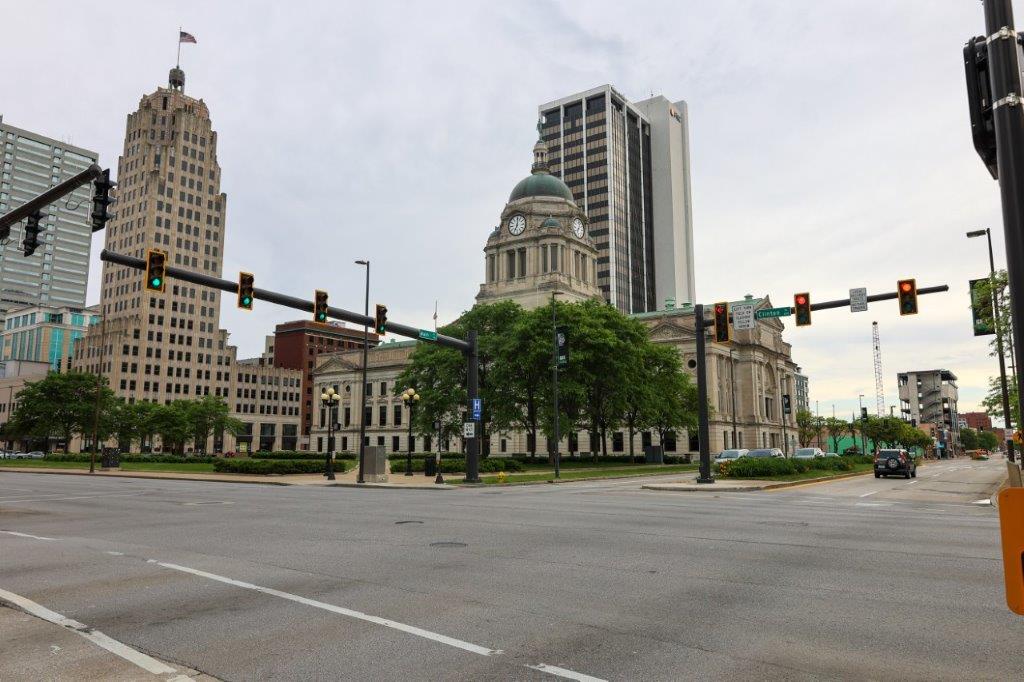Even before the pandemic closed businesses, schools, and scattered millions of Americans to work from home in early 2020, lower income homeowners and renters everywhere were staring down a housing crisis that threatened their ability to put a roof over the heads of their loved ones.
But as the country has started to return to normal, the crisis has remained, as many face rising rental costs and the increasing risk of homelessness.
In an effort to address Fort Wayne’s homelessness problem, city officials in February released its Everyone Home comprehensive plan. The plan calls for an increase in affordable housing stock throughout the Summit city, and improvements and additions to services provided for homeless or near-homeless residents. It also emphasizes coordination between various programs and service providers in order to reach and help at-risk residents before they fall into homelessness.
“Funding for this study came from the pandemic Covid relief funds we got from (the U.S. Department of Housing and Urban Development),” said Kelly Lundberg, Fort Wayne’s director of Housing and Neighborhood Services. “The pandemic showed us that we needed to do a deep dive into our homelessness problem. This is a community plan that belongs to this community.”
According to the plan, researched and written by Homebase, a non-profit public interest law firm, no single measuring tool can calculate the number of homeless people at any given time. Some stay with relatives or friends, or live in vehicles, outdoor encampments, and shelters. Some simply sleep on the sidewalk.
Traditionally, the number of people experiencing homelessness was calculated using data from a survey conducted on a January night every two years, as required by HUD. Rather than relying solely on “Point in Time” counts, which have been criticized for severely undercounting homeless people, Homebase calculated the surge of homeless people using records from shelters, as well as other agencies that serve people struggling with housing crises.
Homebase found:
- Fort Wayne Community Schools assisted 940 families struggling with homelessness during the 2021-22 academic year.
- In 2021, social service agencies assisted more than 2000 individuals who reported experiencing domestic violence, that left them homeless.
- There are just 31 units of permanent supportive housing in the city for people living with disabilities.
- One out of four households in Fort Wayne spend more than 30 percent of their income on housing.
Just 8 percent of rental units in Fort Wayne are affordable to those households with incomes that are less than 30 percent of the area median income.
“This has hurt a lot of people”
Investigators found that the primary barrier for “cost burdened” individuals and families is the lack of safe and affordable housing units in the city. A person or family is considered “cost burdened” when they must spend more than 30 percent of their income on housing.
Many of the area’s affordable housing units are in poor repair, or even uninhabitable, the study found. Additionally, Residents who receive food stamps or housing vouchers under the federal housing program known as “Section 8” report that it’s difficult to find a landlord willing to rent to them. Homebase’s report also found that the “burdens” fall disproportionately on Black residents, whose rate of homelessness is more than twice their percentage of Fort Wayne’s population. The shortage leaves many families clinging to substandard, often dangerous, houses or apartments, unable to afford rapidly escalating rents that landlords are legally permitted to raise. Currently, the median rent for any housing unit in Fort Wayne is $1,200, according to the online real estate search engine Zillow.
“We have a severe lack of affordable housing units,” said Jim Atz, a community development administrator for Housing and Neighborhood Services. “That drives up rents. If we can increase the housing stock, that will hopefully start driving down rents.”
Atz also said many Fort Wayne houses are being purchased by out-of town investors.
“They’re buying up single detached housing and pricing people out of the market,” he said. “This has hurt a lot of people.”
For people who have slipped into homelessness, nearly all of the shelters in the city impose at least one or several pre-conditions on people they accept. This leaves many people who might otherwise find shelter literally out in the cold. Many young people and members of the LGBTQ community are also left out, vulnerable to abuse and discrimination.
“Shelters have a niche with preconditions,” said Atz. “You have to be sober, or to be of a particular faith to stay in the shelter. There are a wide range of conditions among shelters, like a drug screen, or other pre-conditions.”
The Everyone Home plan also cites a lack of public transportation as a major barrier to finding permanent shelter. Citilink provides limited services and hours for those who work outside of downtown and must depend on public transportation. The plan also points to poor coordination between and among agencies that provide mental health care, substance abuse treatment and health care services, and urges the city to foster coordinated services for individuals who live on the street or in encampments.
Solutions to an Intractable Problem
In his introduction to the plan, co-authored with Josh Gale, executive director of Just Neighbors, Mayor Tom Henry reminded residents that these problems have achievable solutions. The plan goes on to lay out a process for providing services to people experiencing homelessness with few, if any, barriers.
To help those for whom homelessness is a defining and often recurring problem, city officials have embraced Housing First, “low-barrier” shelters as a major step toward helping people find permanent housing, and the services they need.
“Lots of folks remain unsheltered,” Lundburg said. “They can’t find a shelter that will take them because of the pre-conditions. With Housing First, once you get someone in your program, you can work with them on the underlying issues that brought them into the situation, and prevent it from happening again. There is a lower barrier to acceptance with Housing First. Housing First meets people where they are at, assuming that they’re not violent.”
The plan also urges the city to develop more permanent supportive housing to help people with disabilities live permanently in safe housing units. The city is encouraged to provide dedicated facilities for LGBTQ individuals and young people.
To help cost-burdened residents who need access to units they can afford, the plan recommends that the city increase the supply of affordable housing by finding the funding to build more subsidized units. Last fall, Village Premier Apartments was awarded $25 million in tax exempt bonds and 2.1 million in tax rebates to build more than 200 units of subsidized housing at the intersection of South Anthony Boulevard and McKinnie Avenue.
Lundberg said community development officials are constantly on the lookout for existing housing units that can be rehabbed. She said plans are underway to encourage landlords to accept housing vouchers, which helps lower-income residents keep their housing costs at 30 percent of their income.
Lundberg also said she was disappointed in the fate of Senate Bill 202, filed in the Indiana General Assembly this year by State Sen. Fady Qaddoura, D-Indianapolis, which would have allowed tenants involved in a dispute with their landlord to deposit rent each month into an escrow account until the issue is resolved. Lundberg said the bill, which has been relegated to the summer study committee, would have been a boon to tenants who have little, if any, leverage in these cases.
“For elected officials, our hope is that they come alongside and support this, Lundberg said. “There may be some actions that come out of it, maybe an ordinance change or engaging landlords. Our goal is prevention, so the most efficient and cost-effective way to deal with this is to keep people in their units.”
For more information about the Everyone Home plan, visit everyonehomefw.org

